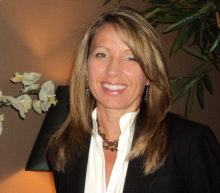Forecasting Deadly Storm Surges
(Inside Science TV) -- When Hurricane Katrina made landfall in 2005, more than 1800 people lost their lives. Many of these deaths, though, didn’t come from the 200 mile-per-hour winds or the heavy rains: They resulted from a devastating storm surge, a phenomenon that scientists are trying to predict with more accuracy than ever before.
Storm surges are unusual rises in water levels caused by a storm. They can be enormously destructive; the storm surge from Hurricane Katrina measured almost 27 feet on the Mississippi Gulf Coast above the normally dry ground, wreaking havoc when it made landfall.
Some of the most destructive hurricanes are "not necessarily big wind events, but big storm surge events," said Jamie Rhome, a storm surge specialist and meteorologist at the NOAA National Hurricane Center in Miami, Florida. "Katrina was certainly from a magnitude perspective, from a loss of life perspective, from a societal impact perspective, one of the worst storm surge events in modern history," he said.
Katrina is hardly alone. In 2008, the storm surge formed by Hurricane Ike caused the waters to rise almost 20 feet above ground along parts of Texas, killing 94 people and leaving behind almost 20 billion dollars in property damage. The storm surge that followed Tropical Storm Sandy in 2012 produced waves of water over 9 feet above normal tides, which slammed into the Northeastern United States, contributing to damage that claimed a total of 145 lives.
"If you look more broadly, historically, at the lives lost in hurricanes, roughly 50 percent occur from storm surge," said Rhome.
Why are storm surges so lethal? Troublingly, it often comes down to the fact that their destruction is literally unimaginable. "If the wind blows hard, a tree falls down, the roof comes off," said Rhome, "it's easier for people to envision this." However, "it's very difficult for people to envision water 5,10, [or] 15 feet inundating entire communities -- that's just beyond what the average person can understand or envision," said Rhome. But the threat is real, he continued, underscoring the need for "a simple and straightforward communications strategy that really says what we know is going to happen in a storm," he said.
[[{"fid":"28206","view_mode":"full_width_image","fields":{"format":"full_width_image","field_image_caption[und][0][value]":"%3Cp%3EIn%20this%20diagram%2C%20a%2015-foot%20storm%20surge%20raises%20a%20typical%20high%20tide%20--%202%20feet%20above%20the%20average%20sea%20level%20--%20to%20a%20monstrous%2017%20feet%20above%20average%20sea%20level%2C%20potentially%20leading%20to%20destruction%20on%20land.%3C%2Fp%3E","field_image_caption[und][0][format]":"full_html","field_image_credits[und][0][value]":"%3Cp%3ENOAA%2FThe%20Comet%20Program%3C%2Fp%3E","field_image_credits[und][0][format]":"full_html","field_rights_information[und][0][value]":"","field_rights_information[und][0][format]":"full_html","field_file_image_alt_text[und][0][value]":"","field_file_image_title_text[und][0][value]":""},"type":"media","attributes":{"height":420,"width":900,"class":"media-element file-full-width-image"},"link_text":null}]]
In response to such a pressing need, Rhome and his colleagues at the National Hurricane Center have developed a new warning system that informs the public 36 to 48 hours in advance of a storm surge event. To Rhome, storm surges shouldn’t be treated any differently from other weather events. “For all other hazards we have a warning," said Rhome. "We have tornado warnings for tornadoes; we have flash flood warnings for heavy rain; we have hurricane warnings for heavy wind; [and] now, we need a storm surge warning to cover the threat from ocean water flooding land," he said.
To build their storm surge forecasts, Rhome and his colleagues use networks of tide stations stationed along coastlines. These stations measure changes in the water level along the coast, taking into account wind speeds and tides, in addition to the location, size, and speed of an incoming storm or hurricane. The warning system then combines this data into a color warning system. An orange warning indicates a storm surge watch, which means that storm surges are possible -- a "heads-up that something might be coming," said Rhome. A red warning, however, indicates that there is "a sufficient enough risk for life-threatening conditions that you need to take action," said Rhome.
Before this warning system, communicating the dangers of storm surges to the public was difficult to do.
"You had to be sort of a storm surge expert to even understand our forecast," said Rhome. "Now we’re shifting to much simpler ways to not only talk about the phenomenon but to show it in these maps," he said.
Starting June 1 -- the beginning of the 2015 hurricane season -- forecasters have been given a preview of the storm surge warning system, which will be the first of its kind in the United States when fully implemented. They need time, though, to get the system working. "The idea is to begin a slow evolution towards a fully operational storm surge watch/warning by the 2017 hurricane season," said Rhome.
When the warning system comes fully online, we will finally have a way to give people living in high-risk areas advance warning of a storm surge -- undoubtedly saving lives in the next big storm.
Editors' Note (7/24/2015): We have updated the article to include corrected statements about the number of deaths from Hurricane Katrina and the height of its storm surge. We apologize for the earlier errors.

